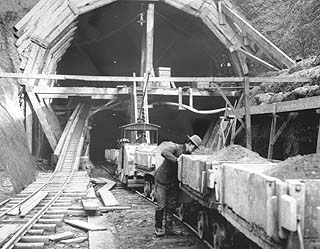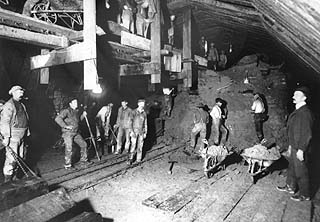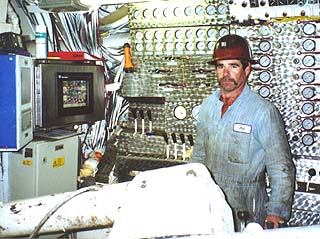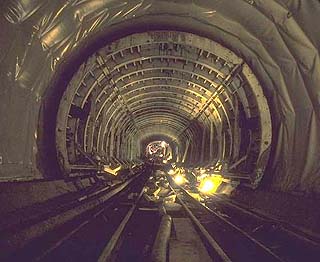
Surveys
DJC.COM
November 21, 2002
Tunneling in Seattle: the long and short of it
Shannon & Wilson

Robinson |
Over 100 tunnels have been built here, with a total estimated length of over 40 miles. The evolution of tunneling technology in Seattle closely mirrors worldwide advances.
Pioneering news in soil tunneling and tunnel contracting came from the area. Recent innovations in pressure balance machine technologies, computerized monitoring of tunnel boring operations and laser guidance, and concrete linings have been applied by designers, owners and contractors — all tested and proven in Seattle’s challenging terrain and glacial soils.

Photo courtesy University of Washington This photo of the south portal of the Great Northern Railroad Tunnel was taken in 1903.
|
Underneath it all
The geology in the Seattle area consists of over 3,000 feet of soil deposited during at least six glacial and non-glacial periods of the Pleistocene Epoch (2 million years ago to about 13,000 years ago). Layers of deposited soils have been eroded, sculpted and consolidated by successive glaciers thought to have been over a half-mile thick. During the last 13,000 years, post-glacial deposition and erosion of sediments by a variety of sources have further modified the landscape.
Due to the multiple glaciations and intervening and subsequent erosion and deposition of non-glacial sediments, the geologic conditions beneath Seattle are highly variable and complex, resulting in major impacts on the selection of construction methods and the ultimate success or failure of tunnel projects.
Also under us are a variety of non-glacial deposits of peat, clay, silt, sand and gravel deposited by lakes, rivers, streams and along the ocean.
Soil conditions are further complicated by the possible presence of: buried logs such as the “buried forest” encountered during construction of the Great Northern Railroad Tunnel; man-made obstacles such as temporary tiebacks for large building basement shoring, steel and timber piles, buried riprap-armored old shorelines, and steel cables from logging mills and other industrial facilities; and naturally occurring methane gas.

Photo courtesy University of Washington Excavation of core soils was done using shovels and wheelbarrows in the upper heading of the Great Northern Railroad tunnel. |
Digging through history
The first tunnels in the Seattle area were excavated by hand with shovels and picks and lit with candles. Ventilation, if used, was powered by mules or horses at ground surface. Pipes driven into the tunnel face were used for dewatering. Timber ribs and lagging provided initial structural support. Final support was provided with a lining of brick for most sewer tunnels, and concrete for larger railroad and highway tunnels. Excavated spoil was removed with wheelbarrows or by rail-mounted push-cars.
After 1930, advances in technology included the use of pneumatic spaders (similar to jack hammers), the introduction of steam and electric shovels and cranes, and extensive use of diesel, gasoline or electric locomotives to haul spoil and construction materials. Ventilation was still not used extensively. Steel ribs were introduced for initial support, while final support was commonly cast-in-place concrete formed with telescoping steel shuttle forms expanded with mechanical screw jacks.
The original Mt. Baker Ridge Twin Highway Tunnels were constructed in the early 1940s through a ridge of hard silt and clay. High soil loads caused settling of the wall posts and arch by as much as 8 inches. Locally, the 12-inch-square timber wall sill plates were crushed to as little as 2 inches thick. Surface settlements averaged about 12 inches, resulting in damage to streets, utilities and buildings. Excavation for both portals resulted in landslides covering a block or more. In addition to more sewers, over 20 slide control drainage tunnels were constructed.
| A glossary of glacial soil types: |
|
Glacial till or “hardpan”
A concrete-like soil that blankets much of the Seattle uplands. Glacial outwash Sand and gravel that may contain large amounts of groundwater. Hard glacial clay and silt Eureka! This comes close to being an ideal tunneling medium. Glaciomarine drift Marine deposits intermediate between till and hard clay. |
Advances
Then between 1960 and 1980, advances in the mechanization, safety and efficiency prompted the construction of many tunnels that had not previously been considered feasible. Movable steel barrels or shields were used to protect workers and support the tunnel walls as the tunnel advanced. Tunnel boring machines with rotating cutterheads were used for many soil and rock tunnels. Excavated soil was removed from the tunnel heading with conveyor belts and loaded into rail-mounted muck trains pulled by diesel locomotives. Ventilation using fans and metal ducting was carried forward with the advancing tunnel. Safety rules disallowed the use of gasoline-powered engines for construction to minimize carbon monoxide concentrations. New compressed air regulations were implemented. Dewatering wells using submerged pumps were introduced.
The Lake City Sewer Tunnel was constructed with a closed-face wheel excavator specifically made for the tunnel. Partial dewatering was accomplished along long stretches in order to reduce compressed air requirements. Compressed air guidelines developed for this project were eventually adopted by Washington state.

Photo courtesy R. Robinson, Shannon & Wilson On the Denny CSO/Mercer Street tunnel alignment, 2001, tunneling was continuously monitored by the machine operator with a computerized guidance system. |
A wide variety of new tunnel methods and equipment were developed and introduced in the 1980s. Most notable was the introduction of earth pressure balance machines and slurry pressure balance machines for tunneling through water-laden flowing silts and sands, with groundwater heads of up to 200 feet. These machines use pressure bulkheads similar to a submarine that retains the pressure of the earth and groundwater in front of the advancing tunnel.
Constructed from 1983 to 1986, the new Mt. Baker Ridge Tunnel for I-90 is the largest diameter soil tunnel in the world. The triple-deck, five-lane highway tunnel was constructed using a semi-flexible 65-foot-diameter compression-ring liner. Behavior of the liner was predicted using new modeling methods, and the project applied innovative risk sharing contracting methods. The combined design and contracting approaches resulted in a low bid about half of the engineer’s estimate, and a final construction cost $1.8 million below the bid price of $38.3 million.
Construction of the 6,212-foot-long, 16.8-foot-diameter combined sewage overflow Denny-Mercer Street Tunnel was the first application of fully functional earth pressure balance machines including foam and polymer soil additives to limit ground losses and resulting settlements. The machine averaged about 33 feet per 10-hour shift. Alignment was monitored with a computerized guidance and data acquisition system. Settlements were limited to less than 0.5-inch along most of the alignment.
The long list of tunnels constructed during this period include the Cedar River Pipeline on Beacon Hill, several sewers and some pedestrian tunnels downtown. And don’t forget Seattle’s transit tunnel, completed in 1988.

Photo courtesy R. Robinson, Shannon & Wilson Final unreinforced concrete lining being cast against a PVC waterproofing membrane inside the Downtown Seattle Transit tunnels. |
The next 10 years
Challenges lie ahead for the tunnel industry in the Seattle area as deeper and longer soil tunnels are planned. Of the major tunnel projects scheduled over the next 10 years, none would be possible without state-of-the-art advances in geotechnical exploration, tunnel design, excavation technology, ground support systems and ground improvement techniques that have occurred over the last 20 years.
These projects include Sound Transit’s Link Light Rail. The North Corridor Transit Tunnel involves six miles of twin subway tunnels, while the Beacon Hill Transit Tunnel consists of a mile-long twin-bore tunnel beneath Beacon Hill.
King County’s Henderson combined sewage overflow project will consist of a 3,100-foot-long, 15-foot-wide storm water storage tunnel as well as connector tunnels beneath Interstate 5 and mainline railroad tracks. The Brightwater Project includes over 13 miles of conveyance tunnels to Puget Sound.
The Alaskan Way Viaduct replacement proposed by the state Department of Transportation combines large-diameter tunnels and cut-and-cover tunnels coupled with reinforcement of an aging seawall. Large-diameter bores for deep subway station tubes and for portions of the Alaskan Way Viaduct replacement will require the application of sequential excavation methods for larger diameters and more difficult ground conditions than have been accommodated thus far anyplace in the U.S.
Technology has advanced in a wide range of fields, including metallurgy, hydraulics, concrete additives, lasers and computers. With creative designers, contractors, suppliers and owners willing to try new and innovative methods of tunnel construction, tunneling will speed up even more — despite Seattle’s difficult ground conditions.
Necessity has proven to be the mother of invention.
Robert A. “Red” Robinson is a vice president and director of underground services at Shannon & Wilson. An extended version of this article was originally delivered at The North American Tunneling Conference held in Seattle in May.
Other Stories:
- Ten high-rise office building design trends
- Mixed-use and maximum value
- The big picture shows small schools
- Retail RX
- Architects welcome low income housing challenge
- Hospital renovations can make people sick
- Engaging the community with 'Design Dialogue'
- To green or not to green?
- Getting the most from environmental graphics
- Watch out for changes to stormwater regs
- Local architect has big designs on China
- Making the workplace work even harder
- How to take your firm to the ‘next level’
- Seattle firms look back on a tough year
Copyright ©2009 Seattle Daily Journal and DJC.COM.
Comments? Questions? Contact us.